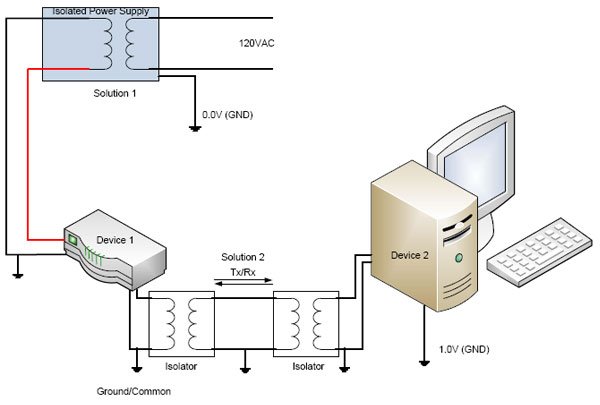Serial Device Isolation & Grounding
Protect Your Serial Devices from Burn Outs and Shorts
The prevention of transients, having proper ground, and isolation are important considerations when implementing a manufacturing control system. Inadequate or faulty protection strategies can lead to premature device and system failures. Though RS485 communications can be reliable at up to 4000 feet, transients, improper grounding, and inadequate isolation can present problems between devices that are only a few feet apart.
This Application Note describes the problems presented by line transients, improper isolation, and inadequate grounding; along with details on strategies to deal with them.
What’s The Problem?
Unfortunately, the first sign of an isolation or grounding problem is either the failure to establish serial communications between two devices, intermittent serial communication connections, or intermittent device failures. These failures are often caused by excess current flowing where it is not supposed to flow. Where does this excess current come from? There are a number of sources.
First, when two serial devices connected by a conductor are at different ground potentials, current flows from the high potential to the low potential. When the ground at one part of the circuit is at a higher potential than the ground at another part of the circuit, unwanted current flows from the serial device with the higher potential to the serial device with the lower potential. Since the designers of the serial device seldom provide the capability to manage this current, the device works normally for hours, days, or weeks until the ICs literally burn up; causing a device failure.
Another possible problem source is transients on the serial data lines. Transients are short bursts of energy which are either wirelessly induced on a serial line, or enter the system from an external source. Lightning is often a cause for transients, but power surges courtesy of your local power company, induced transients from large motors, and improper wiring can all add transients to your serial data lines. These signal distortions sometimes only prevent the receiving device from recognizing a bit as a high or low, but if they’re large enough can destroy the serial receivers in your device.
Not only are your serial devices at risk; but ground loops and transients also do billions of dollars in damage every year to telephone systems, computers, network devices, and other electrical equipment.
How Can This Risk Be Managed?
There are a number of ways mechanisms are used to minimize the risks of this type of problem. Two of the most common ones are 1) Isolating the Power Supply and 2) optically isolating the serial communication lines.
An Isolated Power Supply transformer couples power from the input to the output. Electrical noise in the ground plane from lighting, magnetic field issues, and nearby equipment is prevented from entering the communication system. An example of this is shown in the upper portion of Figure 1. Though this works well to avoid ground loops and ground transients, it does not prevent noise induced wirelessly.
Another approach is to optically isolate the serial communication lines at each device. In this method, a line powered optical isolator is connected to the serial communication lines at each device, as suggested in Solution 2 of Figure 1. As both the serial transmit and receive lines are connected through optical connections, no current can flow across the communication lines. The disadvantage of this approach is that optical isolation is required at each device.

An alternative solution to this problem is to provide shunting circuitry as close to the serial ports as possible. This shunting circuitry absorbs the undesired currents and voltages, protecting the serial ports. The diagrams shown below are reproductions from some of the Tech Notes on the B&B Electronics website (www.bbelec. com).

What Does RTA Recommend for the 435NBX?
If ground loops or transients are potential problems at your site, Real Time Automation, Inc. recommends the implementation of a B&B isolated power supply. If an AC power source is available, consider using the DR- 30 series of DIN Rail power supplies from B&B. If AC is not available to you, Power-One offers an isolated DC-DC convertor, taking in 15-36VDC, and outputting 15VDC. A chassis mounting kit for this DC-DC convertor is also available.
Also available are V-Infinity isolated power supplies; PTK15 series for DC-DC isolation, and VOF-25 series for AC-DC isolation. Power Electronics also offers AC-DC isolation in their GECA20 Series.
Real Time Automation, Inc. alternatively recommends the implementation of a B&B RS-232 optical isolator part number 9SPOP2, or part number 9POP4 to be placed at the serial port(s) of Real Time Automation, Inc. product 435NBX, and at the serial port(s) of the customer device.
